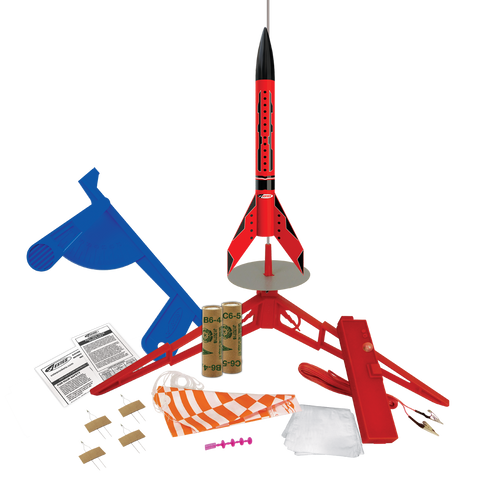Starting a model rocket club for first grade children. I have been associated with Estes since the 70’s
How Estes Rockets' Model Rocket Engines Work
At Estes Rockets, we take pride in providing model rocket enthusiasts with the tools they need to launch their rockets to new heights. At the heart of every model rocket is the engine, which provides the thrust necessary to launch the rocket. In this article, we'll take a closer look at the science behind how our engines work and how they power your launch.
Components of a Model Rocket Engine
Let's first take a look at what makes up an engine. The engine consists of several essential components:
1) Clay nozzle
The nozzle controls the flow of hot gases produced by the burning propellant.
2) Propellant

The propellant is a chemical mixture that burns quickly, releasing a lot of energy in a short amount of time.
3) Delay
The delay is a small amount of powder that produces tracking smoke and allows the rocket to reach its maximum altitude.
4) Ejection charge
The ejection charge creates pressure in the rocket's body tube that triggers the recovery system, such as a streamer or parachute.
5) Clay retainer cap
The clay retainer cap ensures that the ejection charge is held in place until it is needed, preventing it from accidentally deploying during the delay phase.
6) Paper casing
The casing is the outer structure of the engine that keeps the engine components in place and prevents the hot gases from escaping in the wrong direction.
How Does a Model Rocket Engine Work?
Model rocket engines are a perfect example of Newton's Third Law of Motion, which states that every action has an equal and opposite reaction. For instance, igniting the rocket engine creates hot gases that exit the nozzle at high speeds, generating the thrust necessary to propel the rocket into the sky. The nozzle size plays an important role, too: a larger nozzle means more hot gases can be expelled at a higher speed, generating even more thrust and lifting power.

After the engine is ignited, it produces thrust and sends your rocket soaring. When the propellant is used up, the delay charge is activated, creating tracking smoke and allowing your rocket to coast for a little bit. Then, the ejection charge kicks in, and that's when the recovery system is deployed. Whether you're using a parachute or streamer, the ejection charge ensures that your rocket returns safely to the ground.
Choosing the Right Model Rocket Engine
Now that you understand the components of a model rocket engine and how they work, it's time to choose the right engine for your rocket. Choosing the right engine size for your rocket is essential for a successful and safe launch.
Estes Rockets offers a range of model rocket engines in various sizes, including:
1. Mini Engines (13mm): These engines are designed for the smallest and lightest model rockets.
2. Standard Engines (18mm): These engines are the most common size of engines used in model rockets.
3. Large Engines (24mm): These engines are designed for larger model rockets and can reach higher altitudes.
4. XL Engines (29mm): These engines are the largest engines produced by Estes Rockets, providing the most power and highest altitude for model rockets.
There are also four types of engines that we offer at Estes Rockets:
1. Booster: Booster engines provide high thrust at the beginning of a rocket's flight to lift it off the launch pad, with a short burn time of around 1-2 seconds and a high impulse rating.
2. Upper stage: Upper stage engines have a lower impulse rating but a longer burn time than booster engines, used in later stages of flight for a more gradual acceleration.
3. Plugged: Plugged engines are like upper stage engines but have a plastic plug instead of a delay charge, allowing for precise timing of recovery system deployment.
4. Composite: Composite engines use a combination of solid and liquid propellants, have a high impulse rating, longer burn time, and can be used multiple times with a reloadable casing.
Completely New? Get everything you need to launch with a Starter Set
|
This set is designed specifically for beginners and includes all the necessary tools and materials to start building and launching your very first rocket. |
This “Ready to Fly” set is an excellent choice for beginners who want to experience the thrill of model rocketry without having to build one themselves. |
This set is perfect for capturing incredible footage of your rocket in action and provides you with everything you need to get started. |
More Experienced? Check out our Intermediate Kits
|
The Der Red Max delivers impressive sport performance and will give you heights over 500 feet |
The Tandem-X Launch Set offers two high-performance rockets that can reach cloud-busting heights up to 1,150 feet. |
The Big Bertha is an Estes original that has withstood the test of time and is a favorite for modelers, providing a slow, realistic liftoff. |
Estes Rockets' model rocket engines are essential to every successful rocket launch, providing the necessary thrust and power to reach new heights. We hope this article has given you a better understanding of how our engines work and the science behind them. If you're ready to launch your own rocket, visit our website to explore our range of engines and starter kits, and start your rocketry adventure today.














3 comments